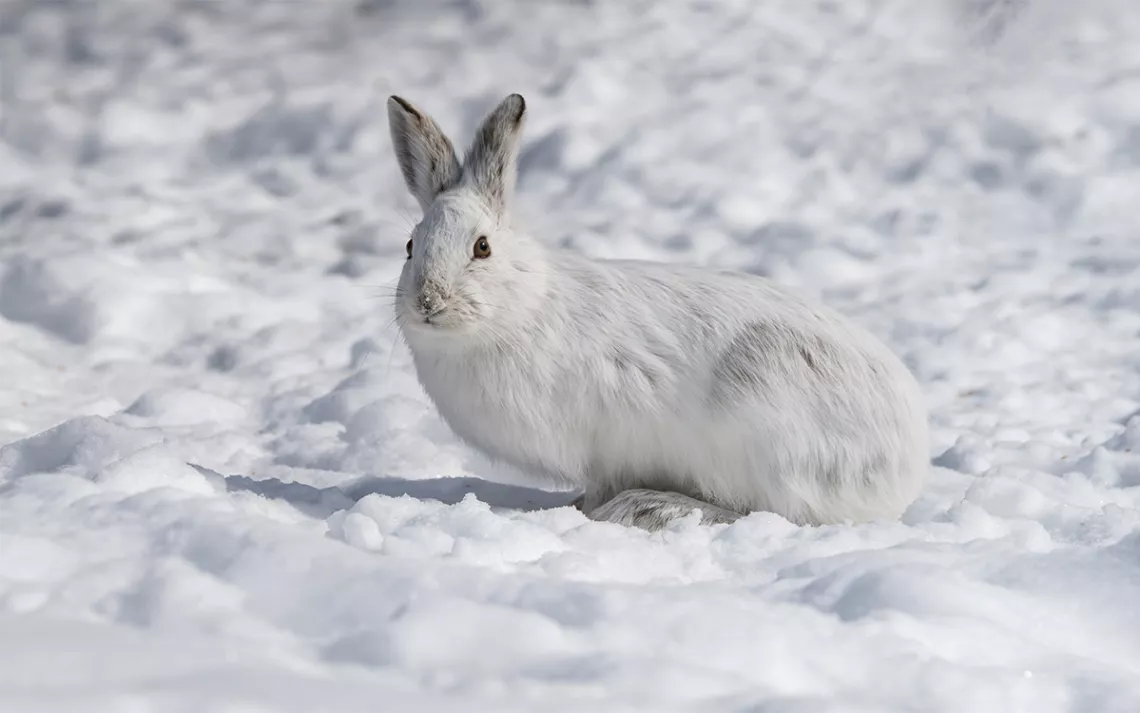Can Snowshoe Hares Adapt to Climate Change?
Savvy hopping tactics may hold the answer

Photo by impr2003/iStock
Every year snowshoe hares molt from brown to white to brown again, in order to stay camouflaged in environments that go from snowy in winter to earthy in summer. But as a warming climate causes snow to melt earlier and earlier, hares sometimes find themselves hopping around on bare, brown dirt while still clad in snowy white, an easy target for predators. This has scientists wondering: Do snowshoe hares know when they’re mismatched like this? And if so, can they adjust their behavior to compensate?
To test how this color mismatch plays out under controlled conditions, postdoctoral researcher Diana Lafferty and her colleagues used the Phenotron, a laboratory at North Carolina State University where both the temperature and the amount of daylight can be controlled to mimic what animals would experience in their natural environment at different times of the year. Using the same soft floor tiles often found in children’s play areas, they created an area inside the Phenotron that was half brown, half white, to mimic the melting snowfields that today’s snowshoe hare often has to navigate.
One by one, 20 captive hares were placed in the middle of the experimental room, inside a “hay hut” shelter similar to the shrubs that they would hide out under in the wild. Then researchers spent the next six hours recording how long it took each hare to leave the shelter and how much time it spent on each color of floor tile. (One particularly rambunctious individual chose to spend its time chewing the shelter hut into pieces.) Then, a month later, they repeated the experiment to see if individual animals behaved the same way that they had before—that is, whether each hare had a way of exploring the world that persisted over time.
When they ran the experiment with hares in their summer brown, the results were clear: The brown hares significantly preferred the brown background. Overall, they stayed there 91 percent of the time. But the strength of this preference varied from animal to animal—some showed more concern than others about which background they were on at all. In theory, this means that natural selection could weed out individuals that are careless about color-matching, enabling populations to adapt to a shifting environment.
"Of course, it’s possible that hares might always prefer to hang out on brown backgrounds, because snow-free spots are warmer and drier, so the crucial next step in the research is to see whether or not this inclination switches once the hares molt into winter white," Lafferty says. The experiments themselves are done, but Lafferty and her colleagues still need to analyze the videos of the white hares’ behavior.
It’s also possible that out in the real world, hares might have other reasons for this preference, or encounter other variables that would change their behavior. A previous study looked at wild snowshoe hares in Montana and found no evidence that they modified their behavior based on their color. Lafferty, however, believes that lab experiments can uncover subtle patterns that are significant but are hard to detect in challenging field conditions.
“Out in the field, the conditions aren’t controlled, and there are a whole lot more variables acting on the animals,” says Lafferty, who recently presented the results obtained so far at the Ecological Society of America’s annual meeting in Portland. “We can tease things apart and get at the mechanisms that are driving different things.” Future plans for the Phenotron include bringing a snow machine into the lab to test how hares behave in a more realistic environment.
Lafferty, a former zookeeper, worked hard to ensure that the hares were as active as they would be in the wild, even though they were living in very controlled circumstances. “Foraging is very important for their physical and mental well-being,” says Lafferty, “so I went out to the forest several days a week to collect pine branches for them. We also had the kong toys that are available for dogs, and we would pack those with hay, and they would roll them around their exhibit.”
Lafferty has completed her postdoc and left North Carolina State University to start a position as an assistant professor of wildlife ecology at Northern Michigan University, but she hopes to stay involved with the snowshoe hare project. She believes this kind of research could eventually be applied to translocation efforts—deliberate attempts to introduce animals into new areas as the environments they need shift due to climate change. “In theory,” says Lafferty, “we could start taking individual personalities into account as one measure of whether or not an animal might be a good fit for relocation.”
Snowshoe hares are just one of around 20 species worldwide, from ptarmigans to arctic foxes to (some) weasels, that go through a seasonal brown-to-white color change. At this point, snowshoe hares are classified as a "species of least concern" in the wild, but as snowfall patterns continue to change, these animals will struggle to keep up with a landscape where they no longer blend in. Twenty hares hopping around on brown and white carpet squares may provide information that, one day, could help these species adapt to an environment that is changing fast.
“And, you know,” says Lafferty, “the bunnies are really cute.”
 The Magazine of The Sierra Club
The Magazine of The Sierra Club



